Opticks : Optical Photon Simulation for Particle Physics with NVIDIA OptiX
Opticks : Optical Photon Simulation for Particle Physics with NVIDIA® OptiX™
Simon C Blyth, National Taiwan University — https://bitbucket.org/simoncblyth/opticks — GTC 2016
Opticks Benefits
Opticks Dramatic Benefits
NVIDIA OptiX applied to neutrino detector simulation : eliminates optical photon bottleneck
- optical photon simulation time --> zero
- optical photon CPU memory --> zero
zero: effectively, compared to rest of simulation
Plus: much improved visualizations
Outline
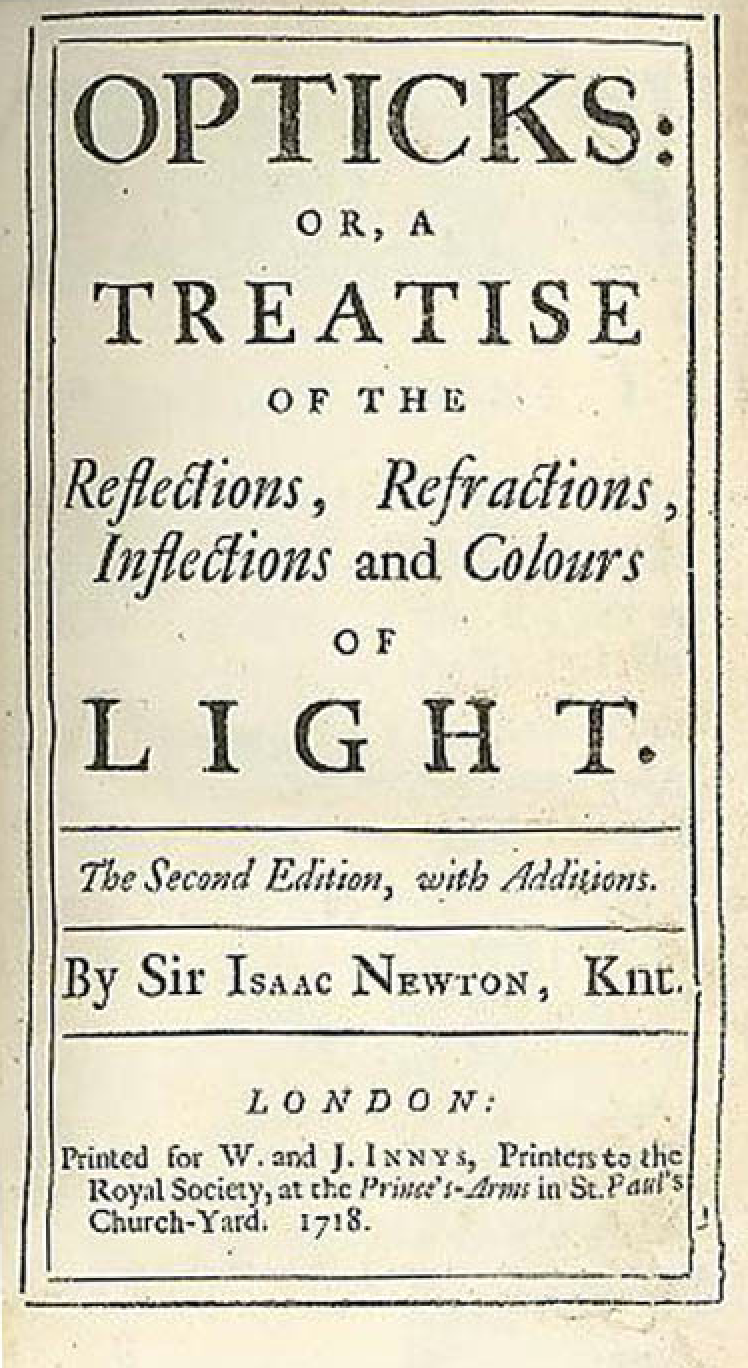
- Context
- Photomultiplier tubes (PMTs)
- Neutrino detectors
- Current simulation approach, Geant4
- How NVIDIA OptiX can help
- Opticks : optical photon simulation with NVIDIA OptiX
- geometry migration
- porting optical physics
- Visualization
- Validation, performance comparisons
- Summary
- Short video
Photomultiplier Tubes (PMTs)


Photomultiplier Tube Operation

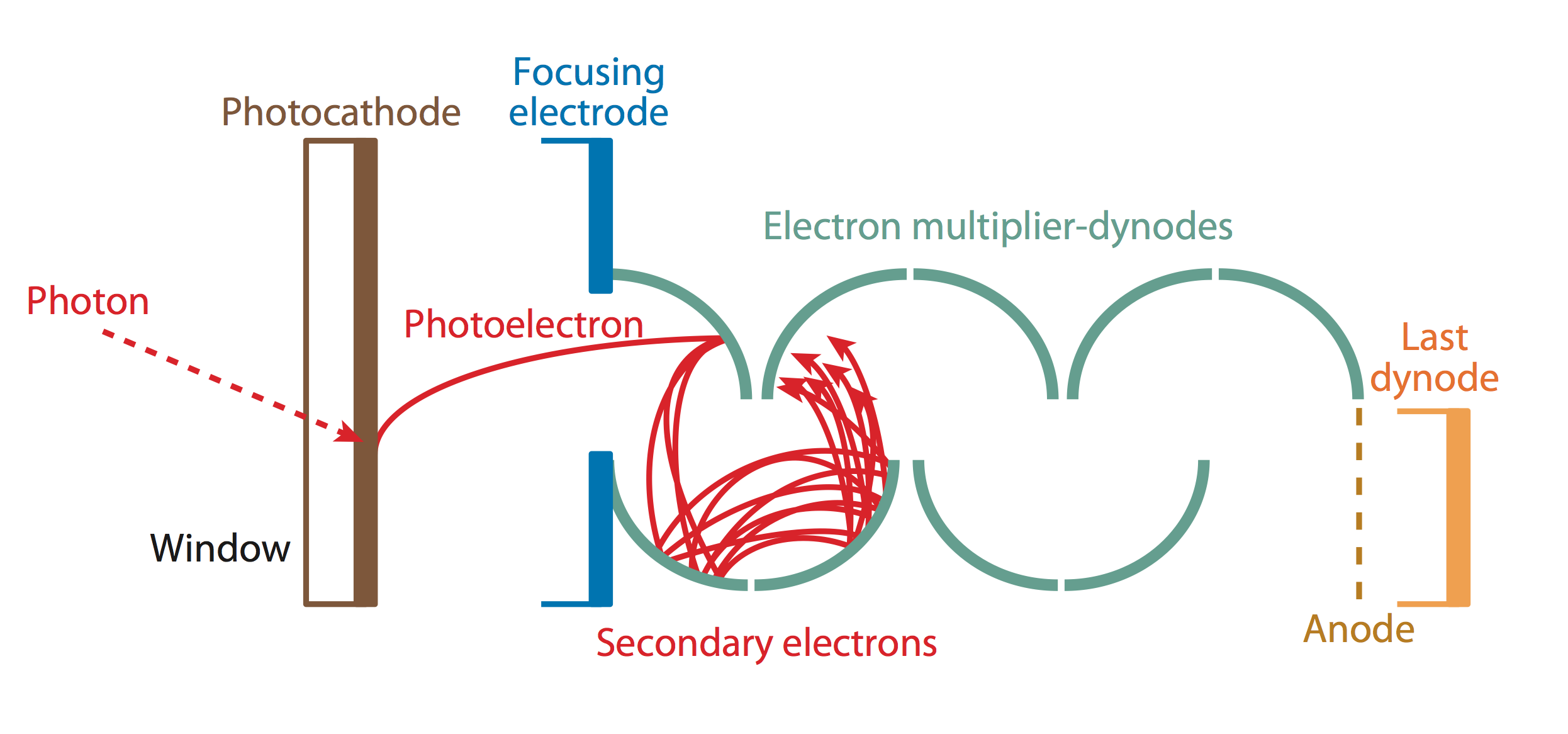
Single photoelectron amplified by ~10 dynodes to yield measurable signal
Super-Kamiokande PMTs 1
© Kamioka Observatory, ICRR(Institute for Cosmic Ray Research), The University of Tokyo.
Super-Kamiokande PMTs 3
Super-Kamiokande Expt
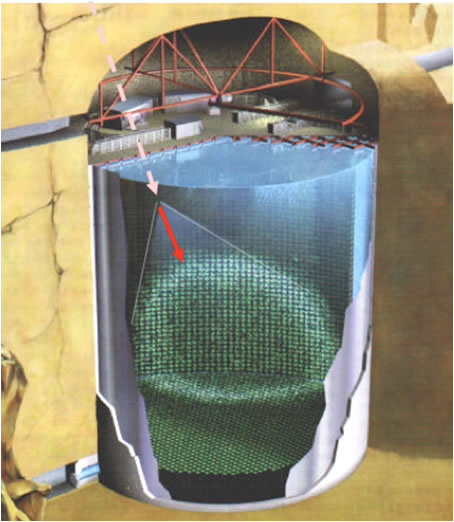
- Neutrino interaction produces charged particles travelling faster than c/n ~ 0.75c
- Cherenkov light cone seen as ring by PMTs
© Kamioka Observatory, ICRR(Institute for Cosmic Ray Research), The University of Tokyo.
Super-Kamiokande PMTs 2
© Kamioka Observatory, ICRR(Institute for Cosmic Ray Research), The University of Tokyo.
Super-K Physics
- First observation of neutrino oscillation
- upward going ~ 0.5 downward going
- -> non-zero neutrino mass
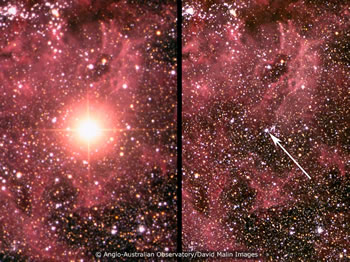
- Observed supernova 1987a burst neutrinos
- 11 neutrinos over 10s
- from nearby galaxy (~160,000 light years)
Jiangmen Underground Neutrino Observatory (JUNO)
Under construction
- neutrino mass heirarchy determination
- 20 kTon liquid scintillator sphere
- 53km from 2 nuclear power plants
- energy resolution: 3% (at 1 Mev)
- PMTs: 17k 20", 17-35k 3"
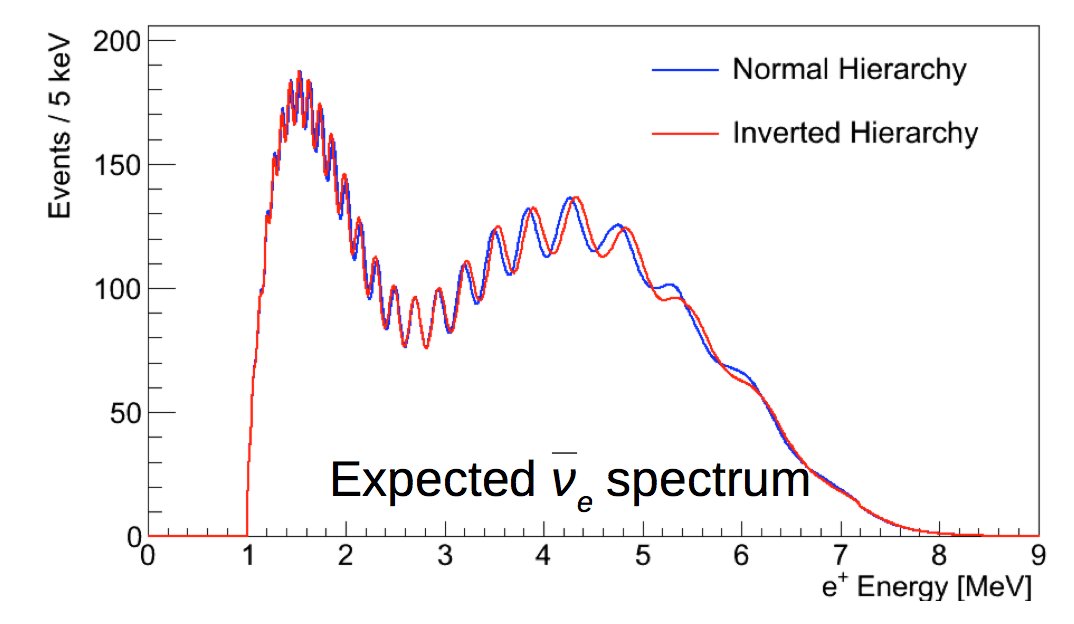
- precise oscillation parameter measurement
- study neutrinos from many sources
Dayabay Reactor Neutrino Expt, Far Site
Daya Bay Far Site 2
Antineutrino Detection
Antineutrinos interact with proton of detector --> positron(e+) and neutron (n).
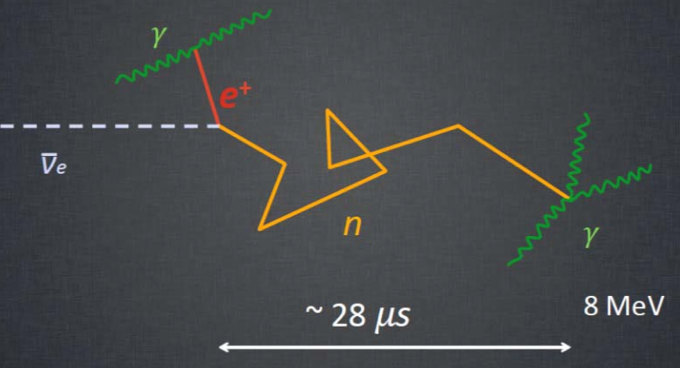
- e+ annihilates, energy deposited in scintillator re-emitted as flash of light
- delayed 2nd flash when gadolinium captures neutron and gamma energy deposited in scintillator
Distinctive double flash of light signature

Daya Bay Far Site 3
Dayabay Physics
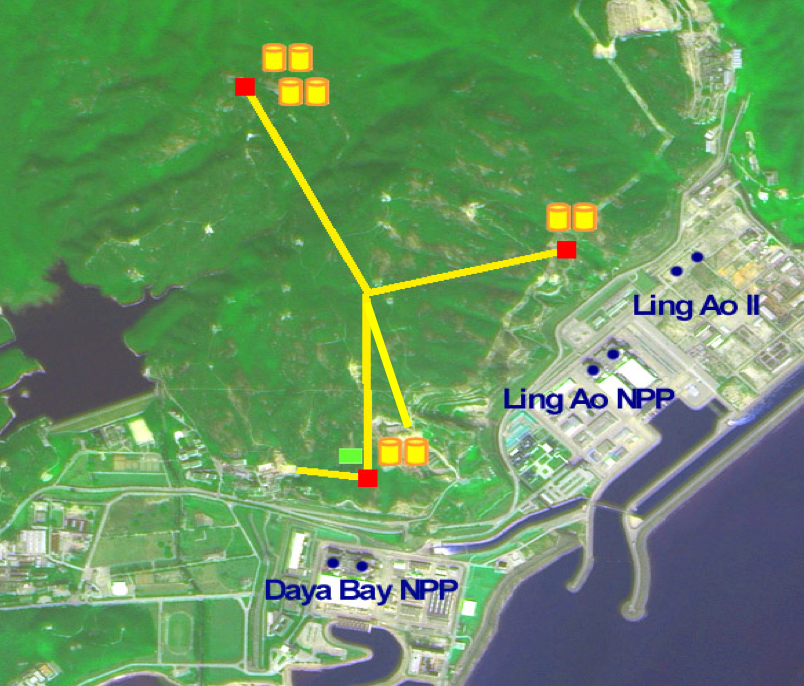
Reactor antineutrino measurements
- Most precise oscillation parameter, theta_13
- Far site baseline ~ 1.9km
- Near/Far comparison : Antineutrino Disappearance
- Most precise antineutrino spectrum
Daya Bay PMT Wall Photo 1
© 2010 The Regents of the University of California, through the Lawrence Berkeley National Laboratory
Geant4 : Monte Carlo Simulation Toolkit
Geant4 : Monte Carlo Simulation Toolkit Generality
Leading in Particle Physics
Geant4 simulates particles travelling through matter
- high energy, nuclear and accelerator physics
- medical imaging, radiotherapy
- space science
Geant4 Approach
- geometry : CSG tree of solids
- particles : track position and time etc..
- processes : nuclear, EM, weak, optical
Very General and Capable Tool
- mostly unused for optical photon propagation
But, there is a problem...
JPMT Before Contact 2
Optical Photon Simulation Problem
Cosmic muons can yield many millions of optical photons in Daya Bay (even more in JUNO). Optical photon propagation dominates Geant4 simulation time ~95% for Daya Bay.
Cosmic Muon Sample sizes severely limited by CPU time and memory practicalities.
Hybrid Solution : Geant4 + Opticks
External propagation possible as optical photons are isolated in simulation chain.
- produced by Cerenkov/Scintillation
- yield only PMT hits
Ray Traced Realistic Image Synthesis and Optical Photon Simulation
OptiX Glass Sample App
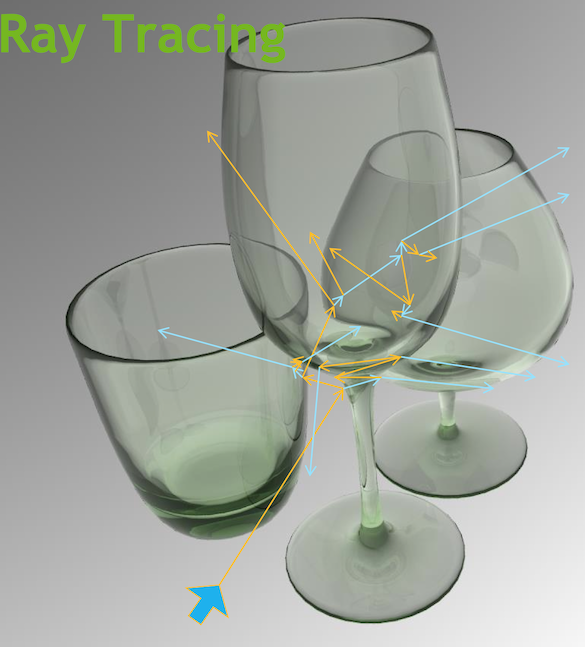
- parallel problems, just different focus
- same limit : geometry intersection
Fast ray tracing can revolutionize optical photon simulation
NVIDIA OptiX Ray Tracing Engine:
- state-of-the-art GPU accelerated intersection
- regular releases: improvements, new GPU tuning
- shared C++/CUDA context eases development
- NVIDIA expertise on efficient GPU/multi-GPU usage
- ~linear scaling with cores across multiple GPUs
NVIDIA OptiX makes massively parallel intersection accessible
Brief History of GPU Optical Photon Simulation Development
Opticks
Opticks aims to replace Geant4 optical photon propagation with an equivalent and drastically faster GPU implementation.
Opticks : ~15 C++ Packages
- recreates Geant4 "context" on GPU
- bridges geometry/event data
- photons generated on GPU (no CPU memory)
- optical simulation by OptiX programs
- photon Indexing by Thrust
- interop between OpenGL/OptiX/Thrust/CUDA
Side Benefit : Performant Visualization
Migrating Geant4 C++ CSG tree geometry to the GPU enables unprecedented visualizations.
2013(Aug-) [liberate geometry from Geant4]
- Develop G4DAE geometry exporter that writes tesselated COLLADA 3D files, including all material and surface properties.
2014 [integrate geometry/event data with Chroma [1]]
- Integrate G4DAE geometries with Chroma
- Develop runtime event data bridge
- GPU Cerenkov/Scintillation photon generation
2015 [replace Chroma with Opticks]
- Develop Opticks with NVIDIA OptiX ray tracing
- Opticks/Geant4 matched for simple geometries
- Speedup factor of 200x with a mobile GPU
2016 [Opticks validation against Geant4]
- Achieved match for single PMT
[1] http://chroma.bitbucket.org Developed by Stan Seibert, University of Pennsylvania.
Migrating Geometry from Geant4 to Opticks
Textures for all properties
- Boundary
- material, surface properties vs wavelength
- Black Body
- generates wavelength according to Plankian distribution from uniform random lookup
- Reemission
- generates wavelength according to measured scintillator distribution from uniform random lookup
Translate Geant4 CSG tree solids into Opticks boundaries:
- inner material : self
- outer material : parent
- inner surface : outwards going photons (self to parent)
- outer surface : inwards going photons (parent to self)
Properties as function of wavelength interleaved into float4 texture.
Texture lookup simplifies OptiX programs
// material property lookup from OptiX programs float nmi = (nm - wavelength_domain.x)/wavelength_domain.z + 0.5f ; float4 material1 = tex2D(boundary_texture, nmi, line + 0.5f ); float refractive_index = material1.x ; float absorption_length = material1.y ; float scattering_length = material1.z ; float reemission_probability = material1.w ; // >0 for scintillators
Large Geometry/Event Techniques
Geometry analysed to find instances
JUNO: ~90M --> 0.1M triangles
- 19,000 20" PMTs
- 34,000 3" PMTs
OpenGL/OptiX instancing
Multiple Renderers
- global, full instances, bbox instances
- rapid switching controls
Split simulation from visualization
- compute mode
- pure OptiX buffers ~7X interop
- visualize by separate event loading
Geometry Modelling : Tesselated vs Analytic Photomultiplier Tubes
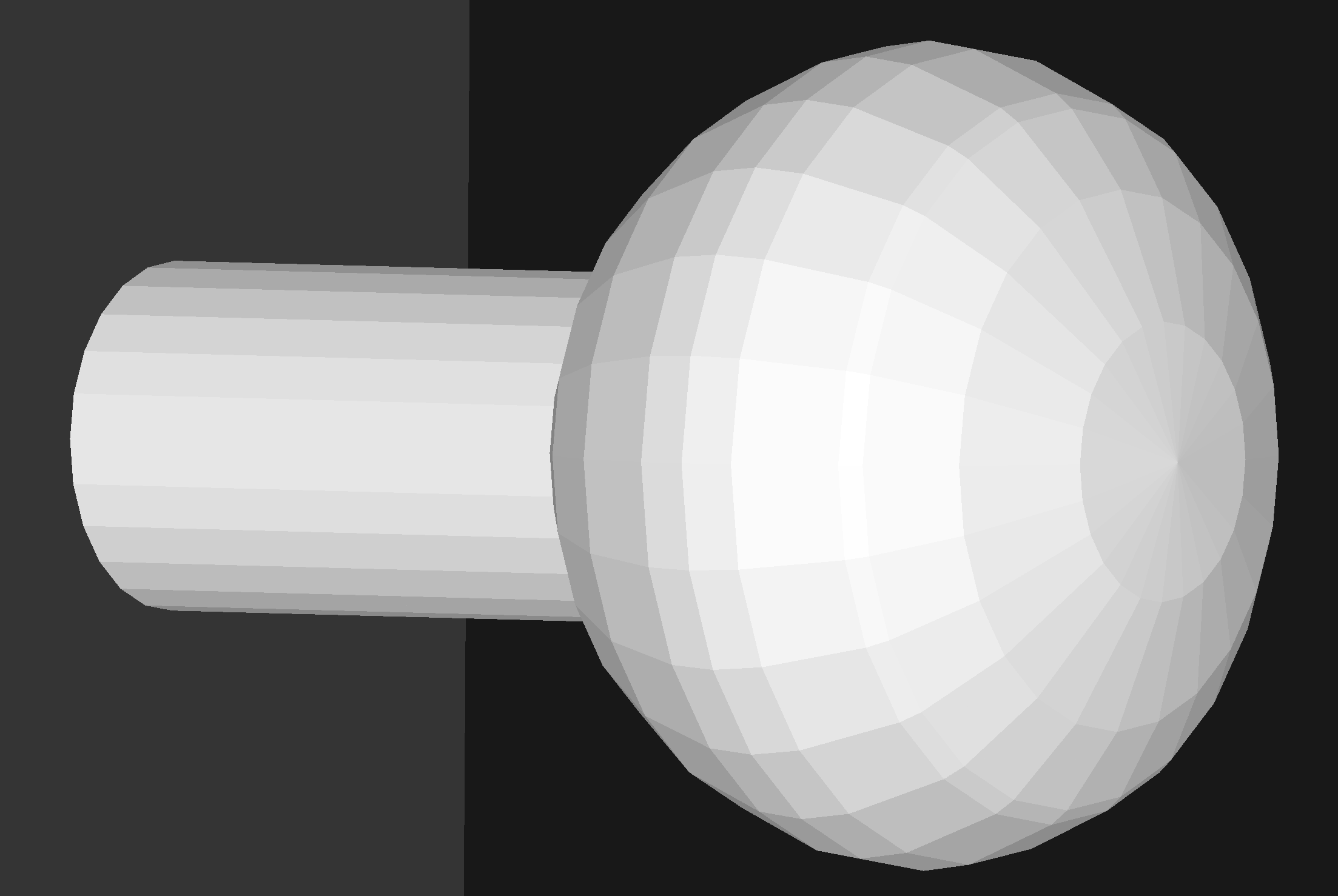
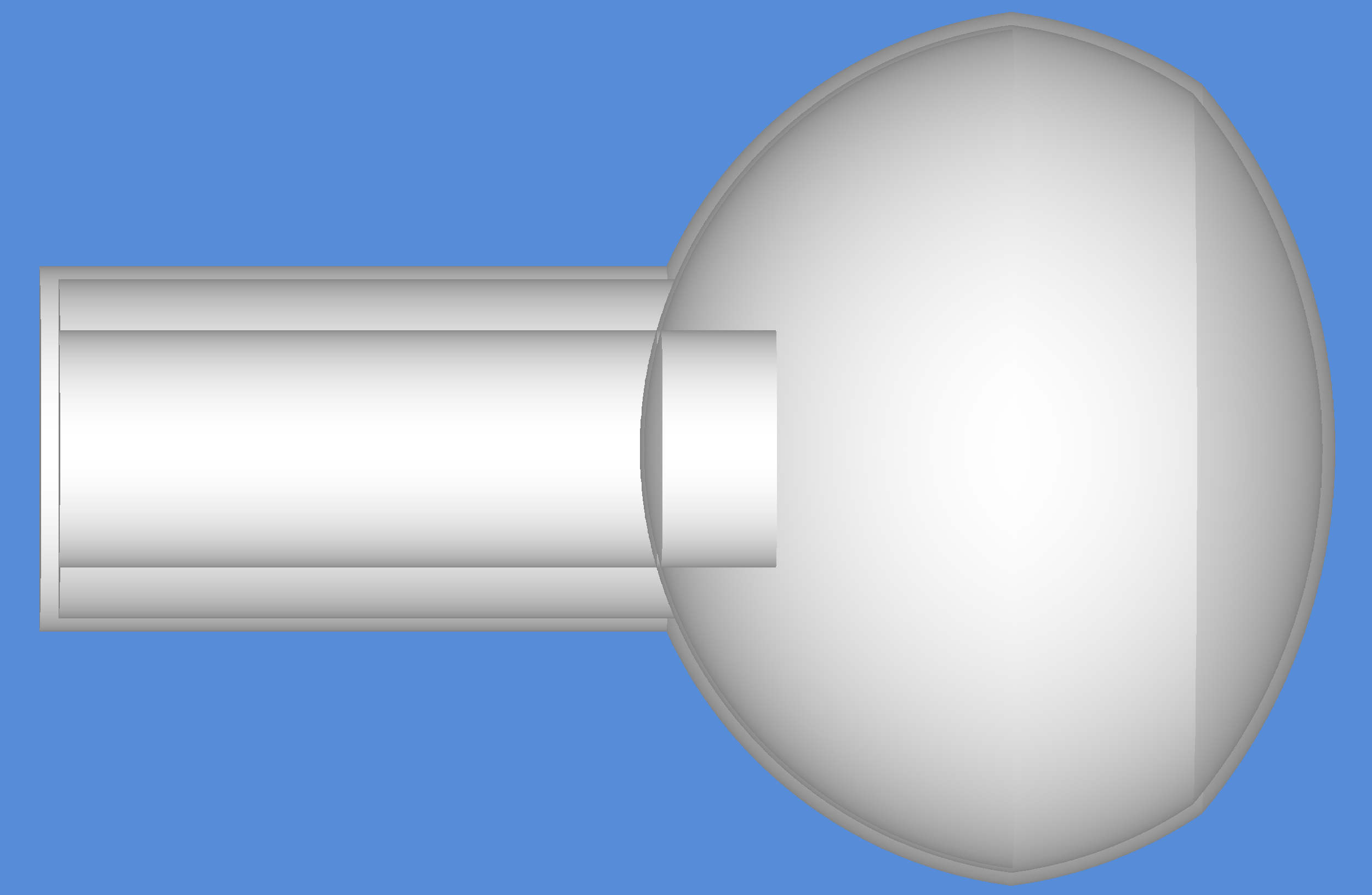

Analytic : more realistic, faster, less memory, much more effort
For Dayabay PMT:
- partition CSG solids into 12 single primitive parts (instead of 2928 triangles)
- splitting at geometrical intersections avoids implementing general CSG boolean handling
- geometry provided to OptiX in form of ray intersection code
Tesselated Photomultiplier : unrealistic disco ball effect
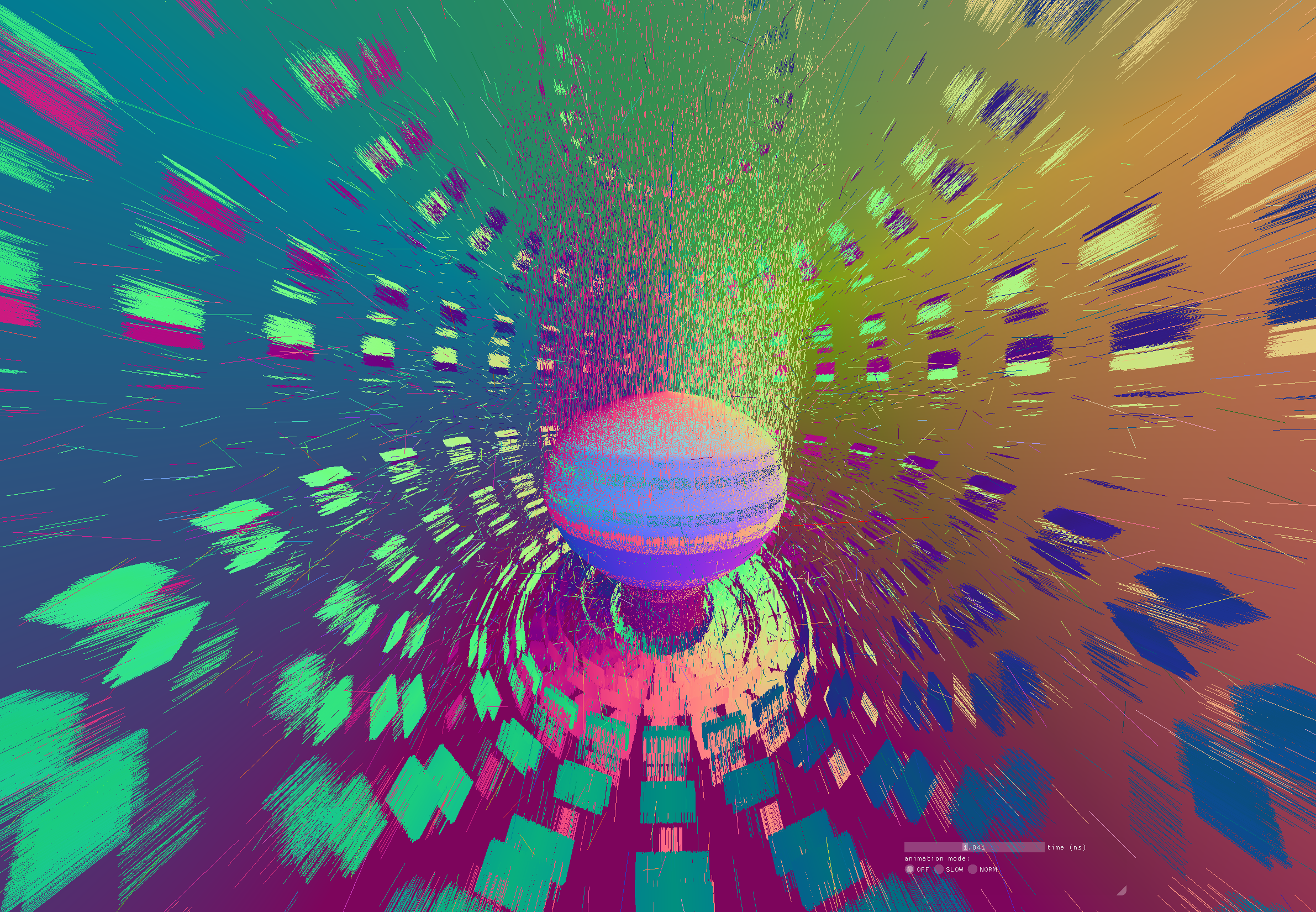
Analytic PMTs together with triangulated geometry
Starting from convenient tesselated geometry, implement analytic geometry for critical parts in primary optical path, to allow very close Geant4/Opticks match.
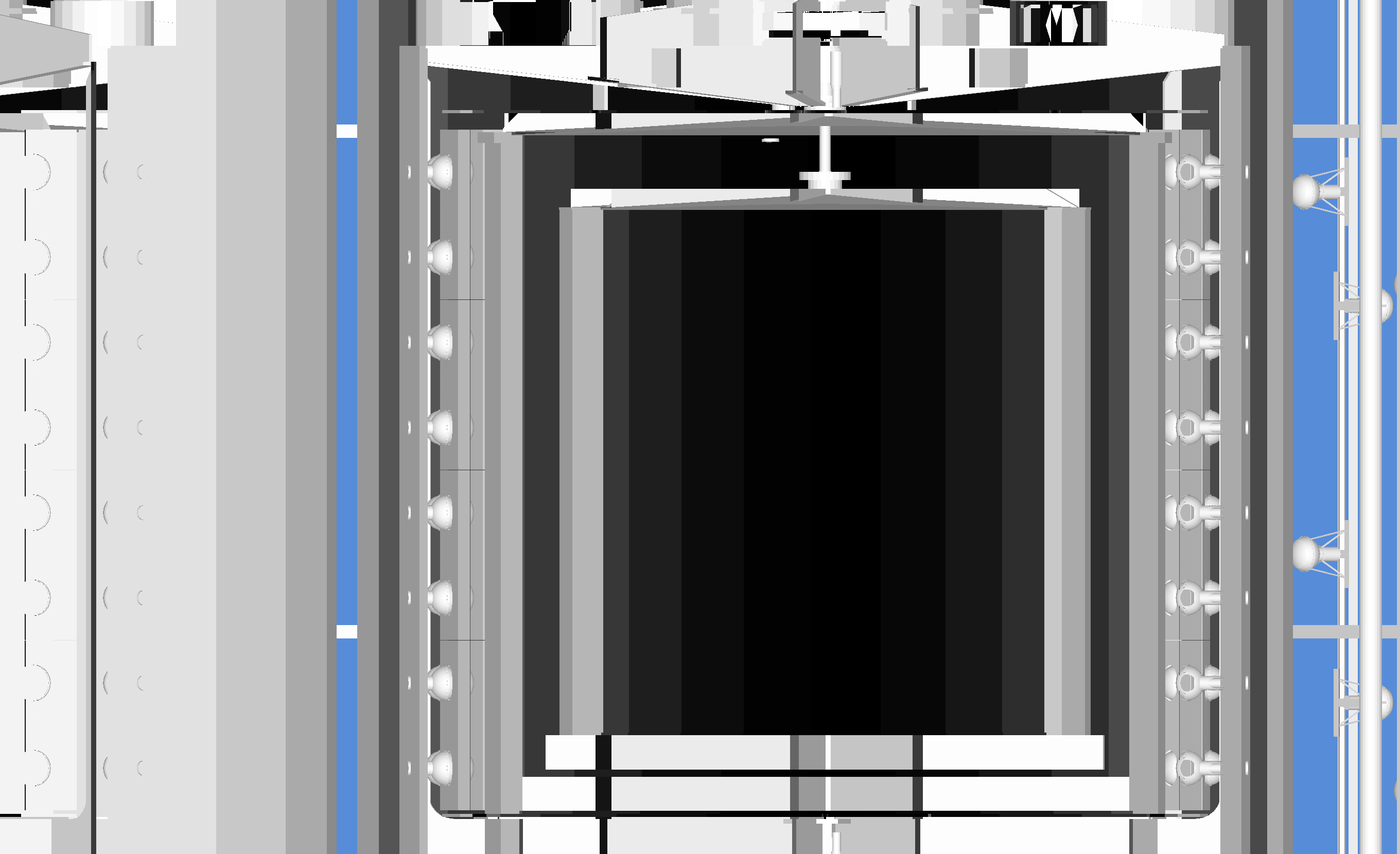
Visualizing An Optical Photon Simulation
Compressed Steps, OpenGL Buffer, written by OptiX
- space for 16 steps per photon
- position, time, polarization, wavelength
OpenGL Geometry Shader: lines -> points/line_strip
- event time is uniform input
- pair validity from step times
- pair selection from step times relative to input time
- interpolation between steps gives position
Interactive: time scrubbing + history/material selection
// geom.glsl
layout (lines) in;
layout (line_strip, max_vertices = 2) out;
void main ()
{
vec4 p0 = gl_in[0].gl_Position ; // p0.w : step begin time
vec4 p1 = gl_in[1].gl_Position ; // p1.w : step end time
...
Compare Opticks/Geant4 Simulations with Simple Lights/Geometries
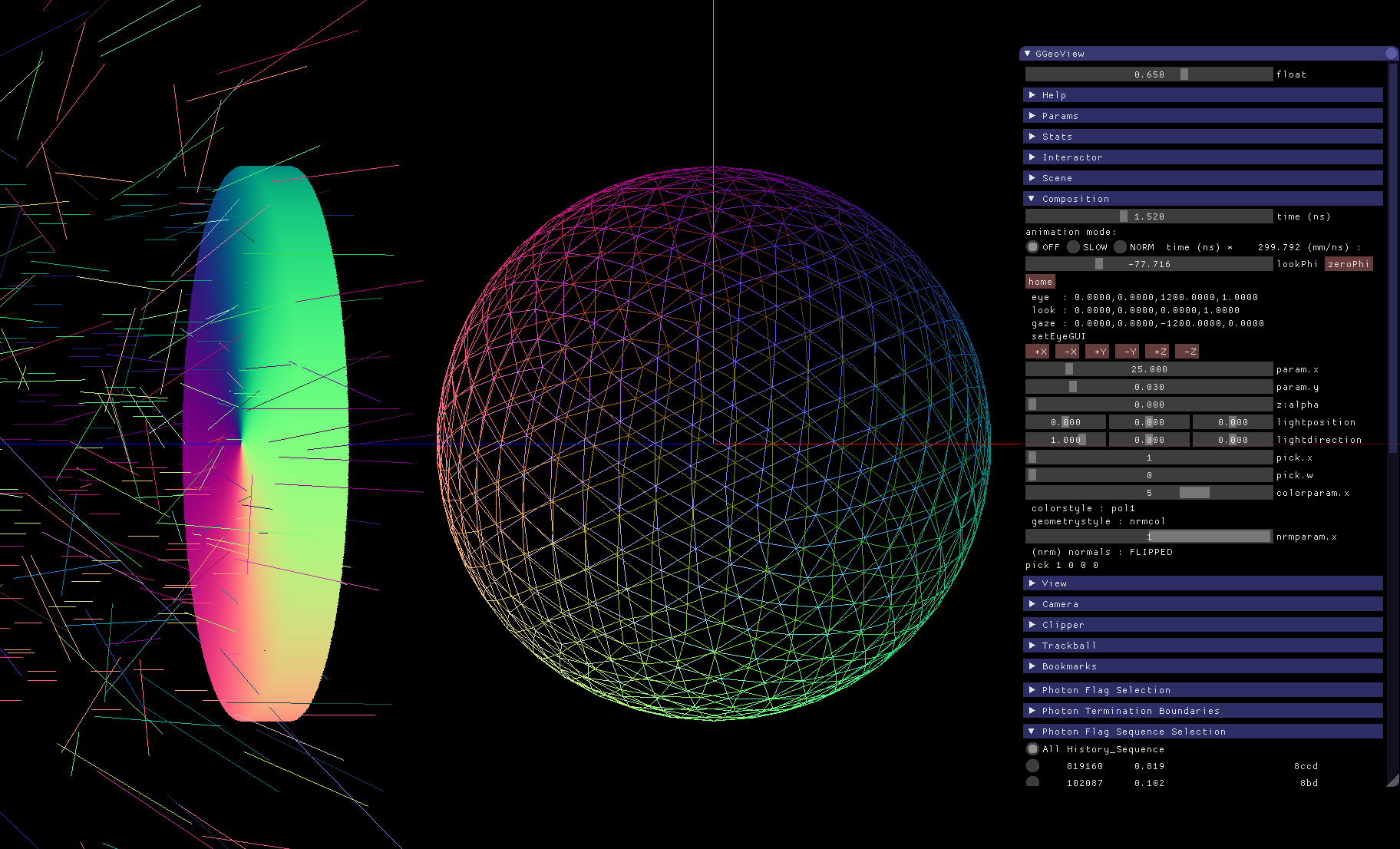
1M Photons -> Water Sphere (S-Polarized)
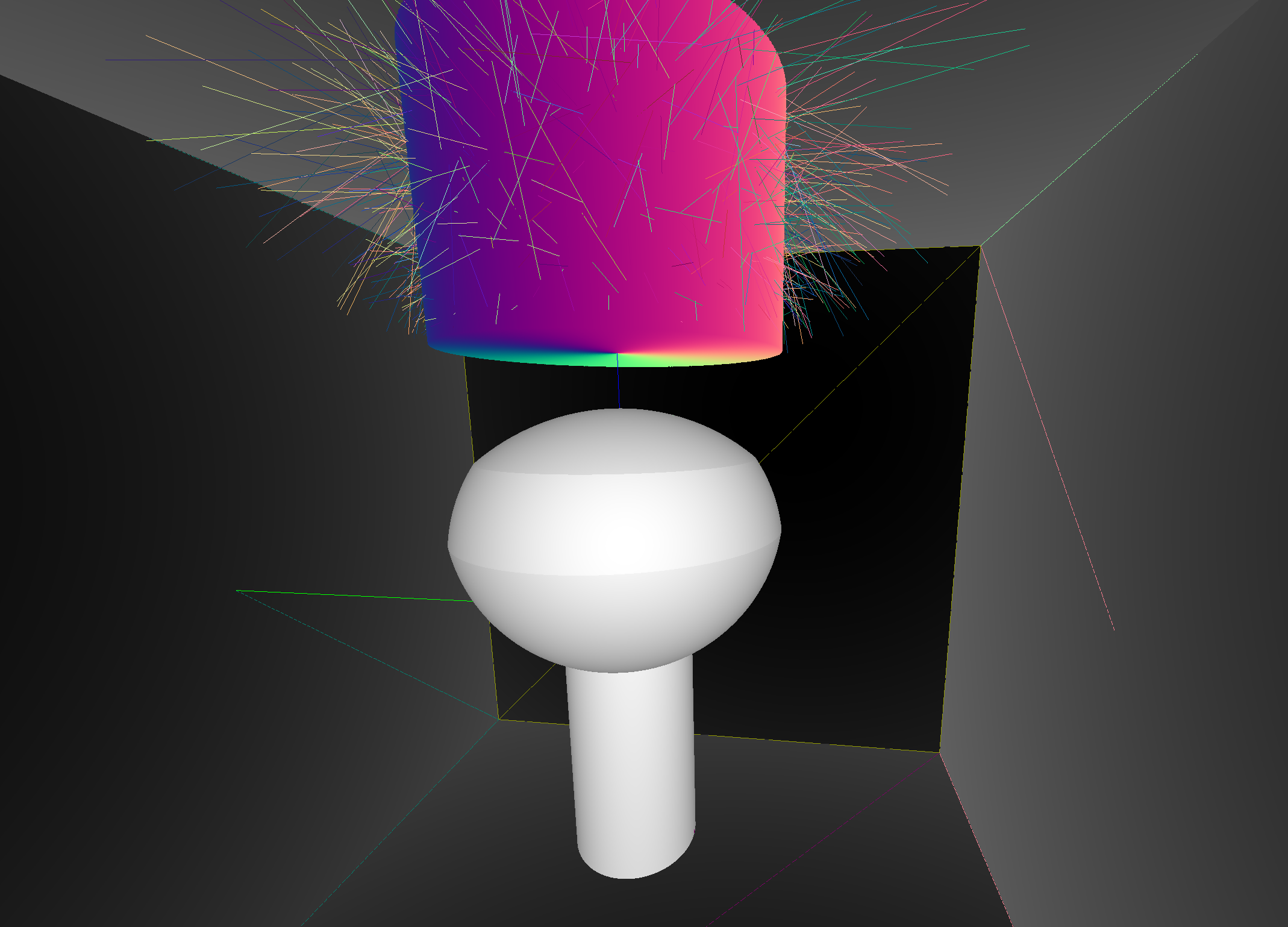
0.5M Photons -> Dayabay PMT

- record steps of all photons : position, time, wavelength, polarization vector, material/history codes
- 128 bit per step (2*short4) : snorm/uchar compressed using known domains
- water sphere : yields multiple rainbows depending on reflections
Opticks/Geant4 Rainbow Step Sequence Comparison
Statistically consistent photon histories in the two simulations
- BT/BR: boundary transmit/reflect
- TO/SC/SA: torch/scatter/surface absorb
64-bit uint Opticks Geant4 chi2 (tag:5,-5)
8ccd 819160 819654 0.15 [4 ] TO BT BT SA (cross droplet)
8bd 102087 101615 1.09 [3 ] TO BR SA (external reflect)
8cbcd 61869 61890 0.00 [5 ] TO BT BR BT SA (bow 1)
8cbbcd 9618 9577 0.09 [6 ] TO BT BR BR BT SA (bow 2)
8cbbbcd 2604 2687 1.30 [7 ] TO BT BR BR BR BT SA (bow 3)
8cbbbbcd 1056 1030 0.32 [8 ] TO BT BR BR BR BR BT SA (bow 4)
86ccd 1014 1000 0.10 [5 ] TO BT BT SC SA
8cbbbbbcd 472 516 1.96 [9 ] TO BT BR BR BR BR BR BT SA (bow 5)
86d 498 473 0.64 [3 ] TO SC SA
bbbbbbbbcd 304 294 0.17 [10] TO BT BR BR BR BR BR BR BR BR (bow 8+ truncated)
8cbbbbbbcd 272 247 1.20 [10] TO BT BR BR BR BR BR BR BT SA (bow 6)
cbbbbbbbcd 183 161 1.41 [10] TO BT BR BR BR BR BR BR BR BT (bow 7 truncated)
1M 64 bit uint flag sequences indexed using CUDA Thrust, 0.040 s (sparse histogram sort)
Rainbow Spectrum for 1st six bows
Spectra obtained by selecting photons by internal reflection counts. Colors obtained from spectra of each bin using CIEXYZ weighting functions converted into sRGB/D65 colorspace. Exposures by normalizing to bin with maximum luminance (CIE-Y) of each bow. White lines indicate geometric optics prediction of deviation angle ranges of the visible range 380-780nm. 180-360 degrees signifies exit on same side of droplet as incidence.
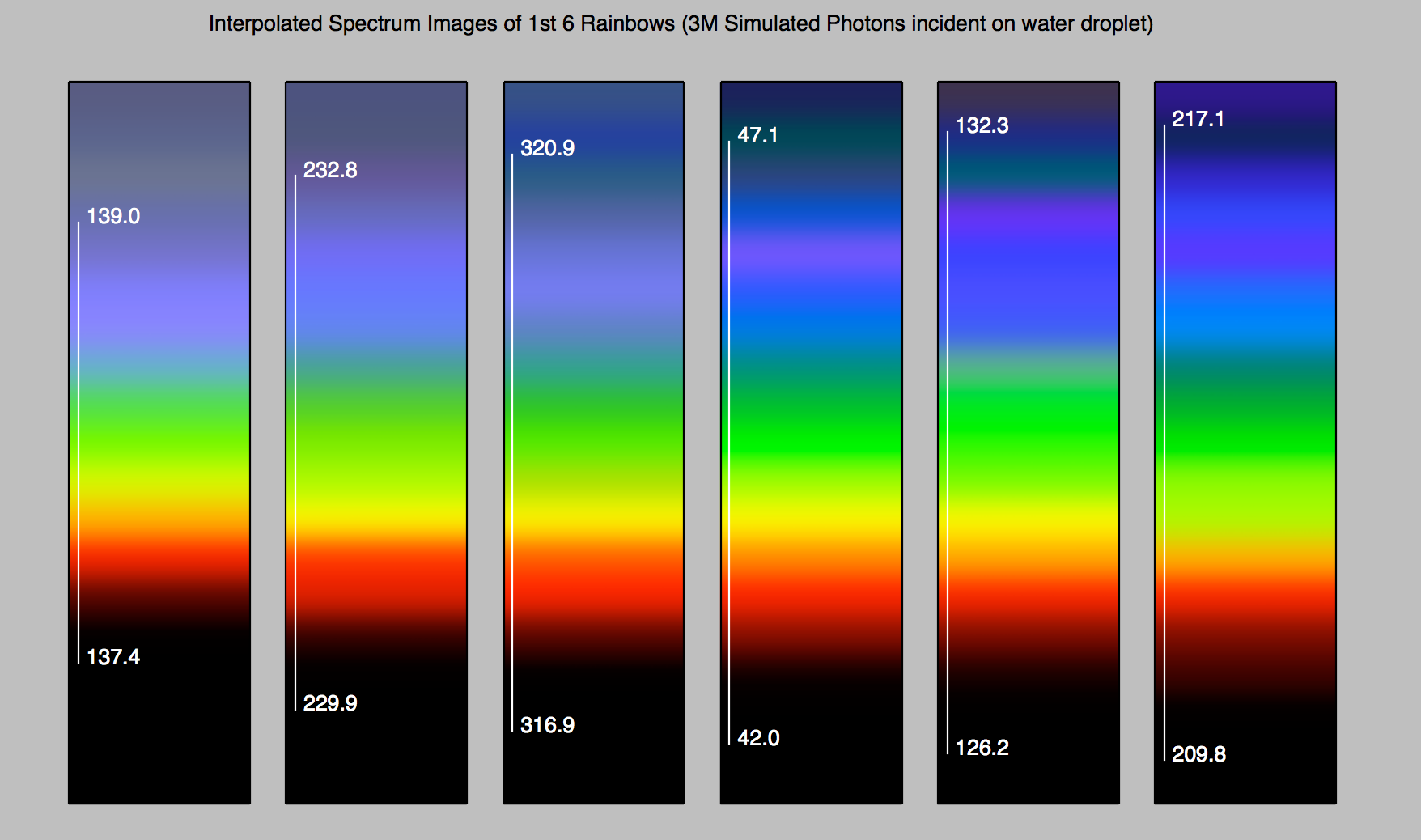
1M Rainbow S-Polarized, Comparison Opticks/Geant4
Deviation angle(degrees) of 1M parallel monochromatic photons in disc shaped beam incident on water sphere. Numbered bands are visible range expectations of first 11 rainbows. S-Polarized intersection (E field perpendicular to plane of incidence) arranged by directing polarization radially.
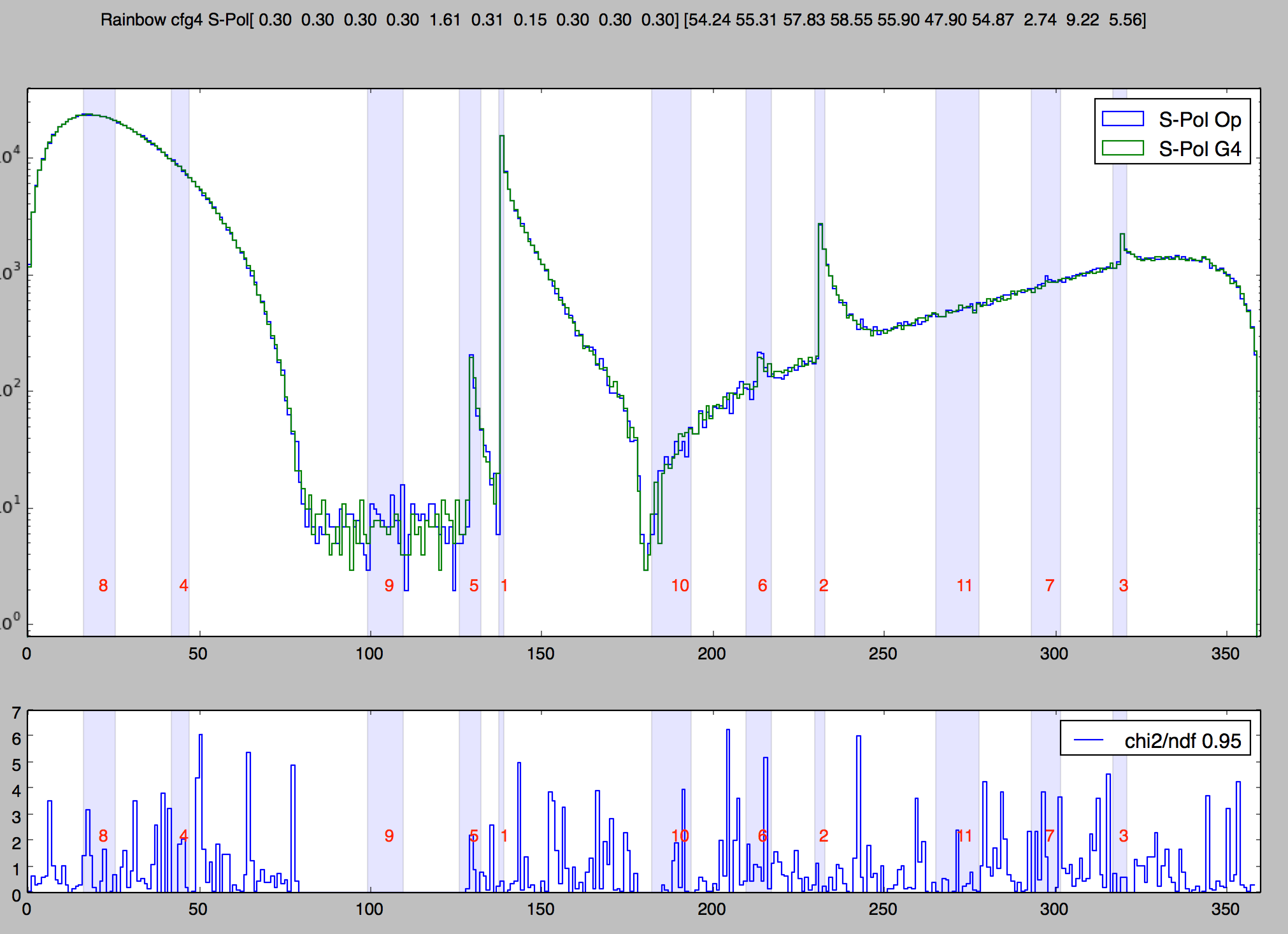
PmtInBox after 1
PmtInBox after 2
Interactive selection
By history or material sequences, eg:
- TO BT SA
- surface absorbed without detection
- TO BT SD
- surface detected on photocathode
- TO BT BT SA
- edge Pyrex crossers (outer ring)
- TO AB
- bulk absorbed
- TO BR SA
- reflected from Pyrex
- TO BT BR BR BT SA
- double Pyrex reflections (inner ring)
BT:boundary transmit, BR:boundary reflect
Implemented with Thrust indexing (sparse histogram sort)
PMT Opticks/Geant4 step distribution comparison TO BT [SD]
Good agreement reached, after several fixes: geometry, total internal reflection, group velocity
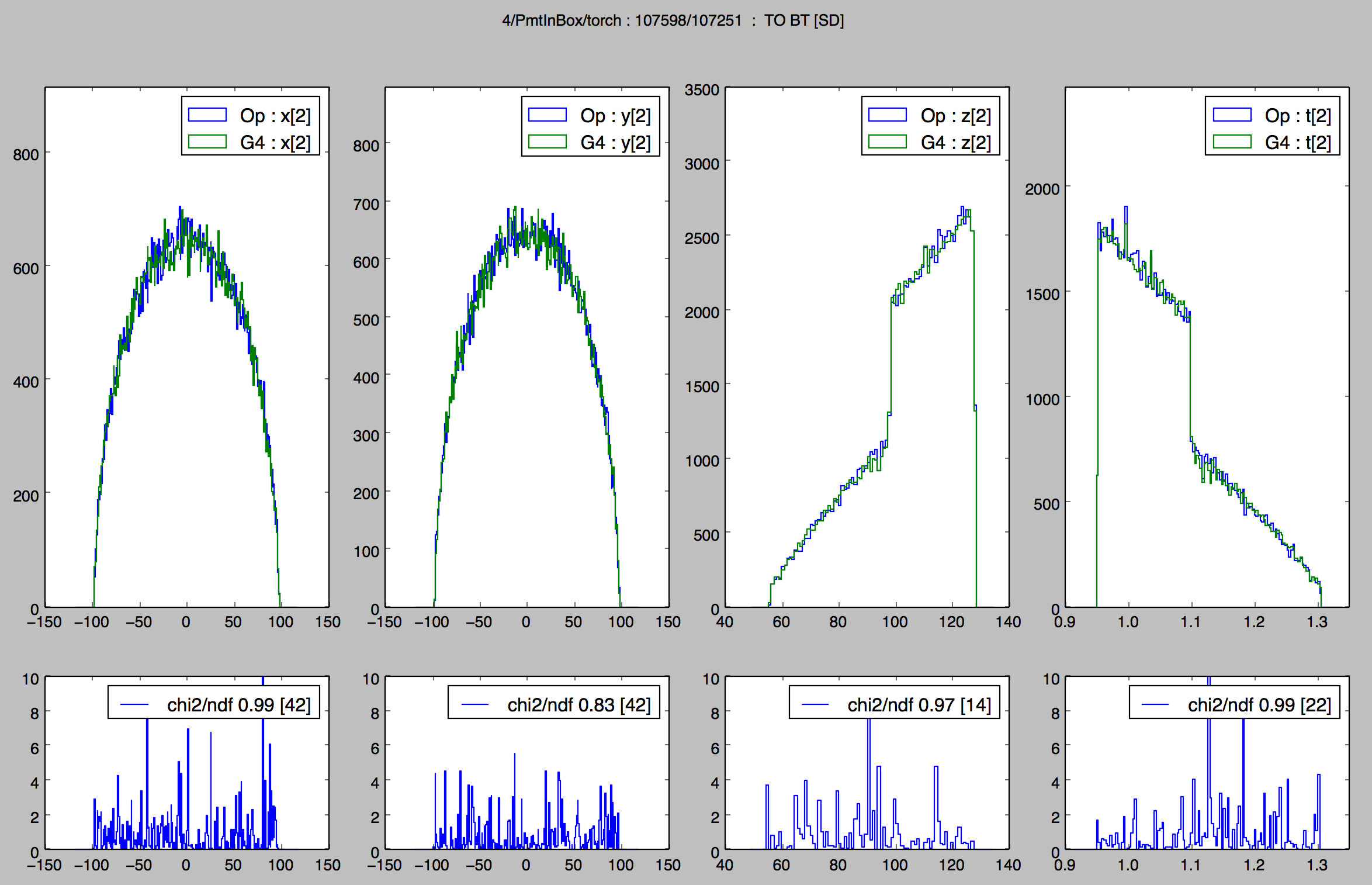
position(xyz), time(t)
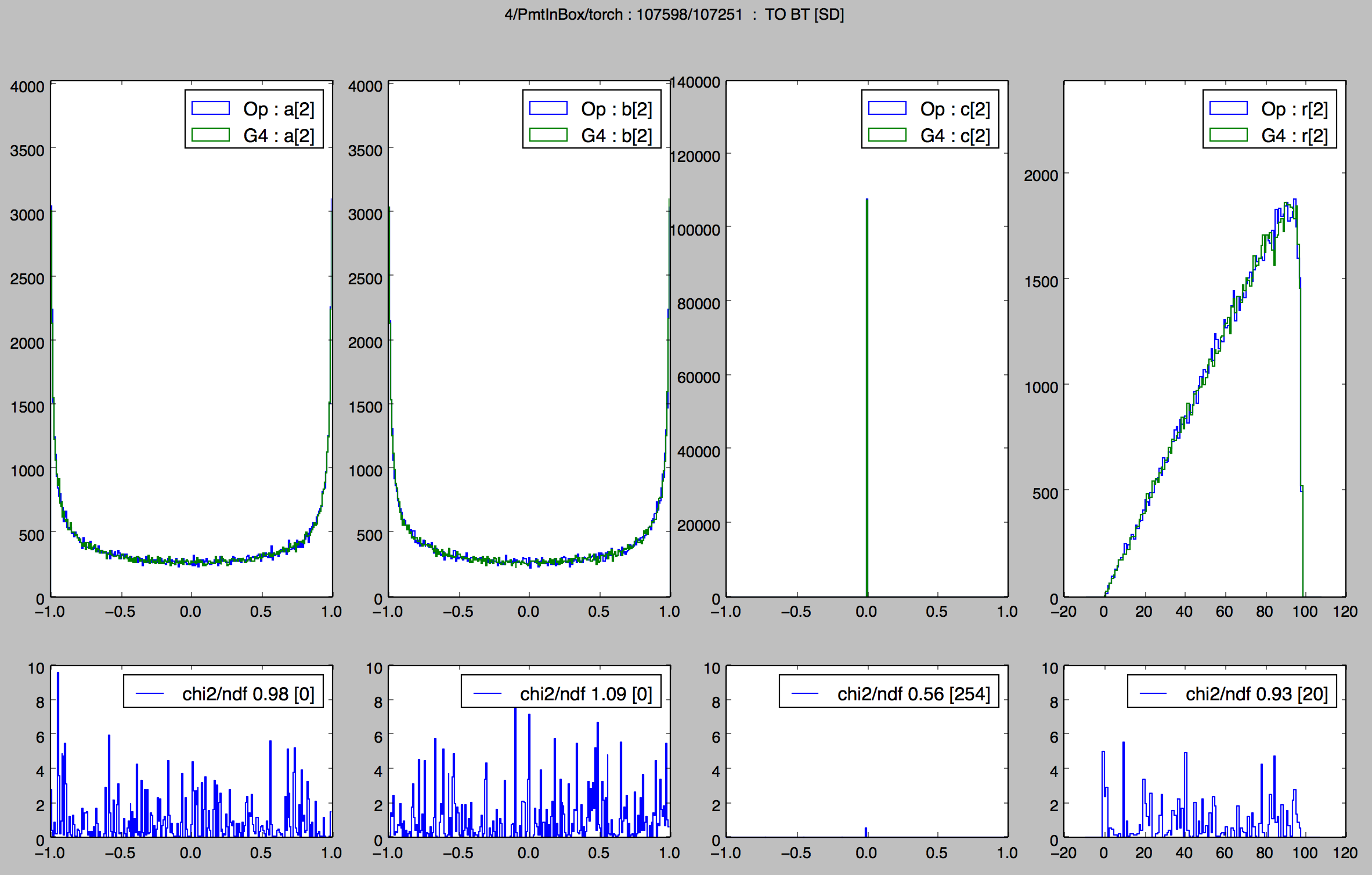
polarization(abc), radius(r)
PMT Opticks/Geant4 step distribution comparison : chi2/ndf
Consistent : chi2/ndf ~ 1
Very good Opticks/Geant4 agreement
- identical geometries
- identical optical physics
XYTZ: position, time ABCR: polarization, radius
| 4/PMT In Box/torch : | X | Y | Z | T | A | B | C | R |
|---|---|---|---|---|---|---|---|---|
| 340271/340273 : [TO] BT SA | 1.15 | 1.00 | 0.00 | 0.00 | 1.06 | 1.03 | 0.00 | 1.21 |
| 340271/340273 : TO [BT] SA | 1.15 | 1.00 | 1.06 | 0.91 | 1.06 | 1.03 | 0.00 | 1.21 |
| 340271/340273 : TO BT [SA] | 0.97 | 1.02 | 1.05 | 0.99 | 1.06 | 1.03 | 0.00 | 1.29 |
| 107598/107251 : [TO] BT SD | 0.91 | 0.73 | 0.56 | 0.56 | 0.98 | 1.09 | 0.56 | 0.94 |
| 107598/107251 : TO [BT] SD | 0.91 | 0.73 | 0.81 | 0.93 | 0.98 | 1.09 | 0.56 | 0.94 |
| 107598/107251 : TO BT [SD] | 0.99 | 0.83 | 0.97 | 0.99 | 0.98 | 1.09 | 0.56 | 0.93 |
| 23217/23260 : [TO] BT BT SA | 0.94 | 0.82 | 0.04 | 0.04 | 0.97 | 0.89 | 0.04 | 0.57 |
| 23217/23260 : TO [BT] BT SA | 0.94 | 0.82 | 0.70 | 0.50 | 0.97 | 0.89 | 0.04 | 0.57 |
| 23217/23260 : TO BT [BT] SA | 0.91 | 0.94 | 0.43 | 0.60 | 0.97 | 0.89 | 0.04 | 0.05 |
| 23217/23260 : TO BT BT [SA] | 0.94 | 0.88 | 0.04 | 0.35 | 0.97 | 0.89 | 0.04 | 0.72 |
| 18866/19048 : [TO] AB | 0.99 | 1.10 | 0.87 | 0.87 | 0.85 | 0.84 | 0.87 | 1.00 |
| 18866/19048 : TO [AB] | 0.99 | 1.10 | 0.93 | 0.92 | 0.85 | 0.84 | 0.87 | 1.00 |
| 3179/3133 : [TO] SC SA | 1.07 | 0.83 | 0.34 | 0.34 | 0.86 | 0.96 | 0.34 | 0.73 |
| 3179/3133 : TO [SC] SA | 1.07 | 0.83 | 0.98 | 1.05 | 0.98 | 1.06 | 0.98 | 0.73 |
| 3179/3133 : TO SC [SA] | 0.96 | 1.04 | 0.93 | 0.97 | 0.98 | 1.06 | 0.98 | 1.10 |
| 2204/2249 : [TO] BT AB | 0.85 | 1.04 | 0.45 | 0.45 | 0.99 | 0.92 | 0.45 | 1.06 |
| 2204/2249 : TO [BT] AB | 0.85 | 1.04 | 0.95 | 0.88 | 0.99 | 0.92 | 0.45 | 1.06 |
| 2204/2249 : TO BT [AB] | 0.98 | 0.94 | 1.01 | 1.00 | 0.99 | 0.92 | 0.45 | 0.90 |
| 1696/1732 : [TO] BT BT AB | 1.05 | 0.85 | 0.38 | 0.38 | 0.86 | 1.09 | 0.38 | 0.26 |
| 1696/1732 : TO [BT] BT AB | 1.05 | 0.85 | 1.48 | 1.28 | 0.86 | 1.09 | 0.38 | 0.26 |
| 1696/1732 : TO BT [BT] AB | 0.99 | 0.86 | 1.17 | 1.40 | 0.86 | 1.09 | 0.38 | 0.86 |
| 1696/1732 : TO BT BT [AB] | 1.15 | 0.88 | 1.08 | 1.06 | 0.86 | 1.09 | 0.38 | 0.79 |
| 1446/1455 : [TO] BR SA | 1.21 | 0.94 | 0.03 | 0.03 | 0.90 | 0.87 | 0.03 | 1.09 |
| 1446/1455 : TO [BR] SA | 1.21 | 0.94 | 1.02 | 1.01 | 0.90 | 0.87 | 0.03 | 1.09 |
| 1446/1455 : TO BR [SA] | 1.00 | 0.93 | 0.97 | 0.99 | 0.90 | 0.87 | 0.03 | 1.04 |
Photon Propagation Times Geant4 cf Opticks
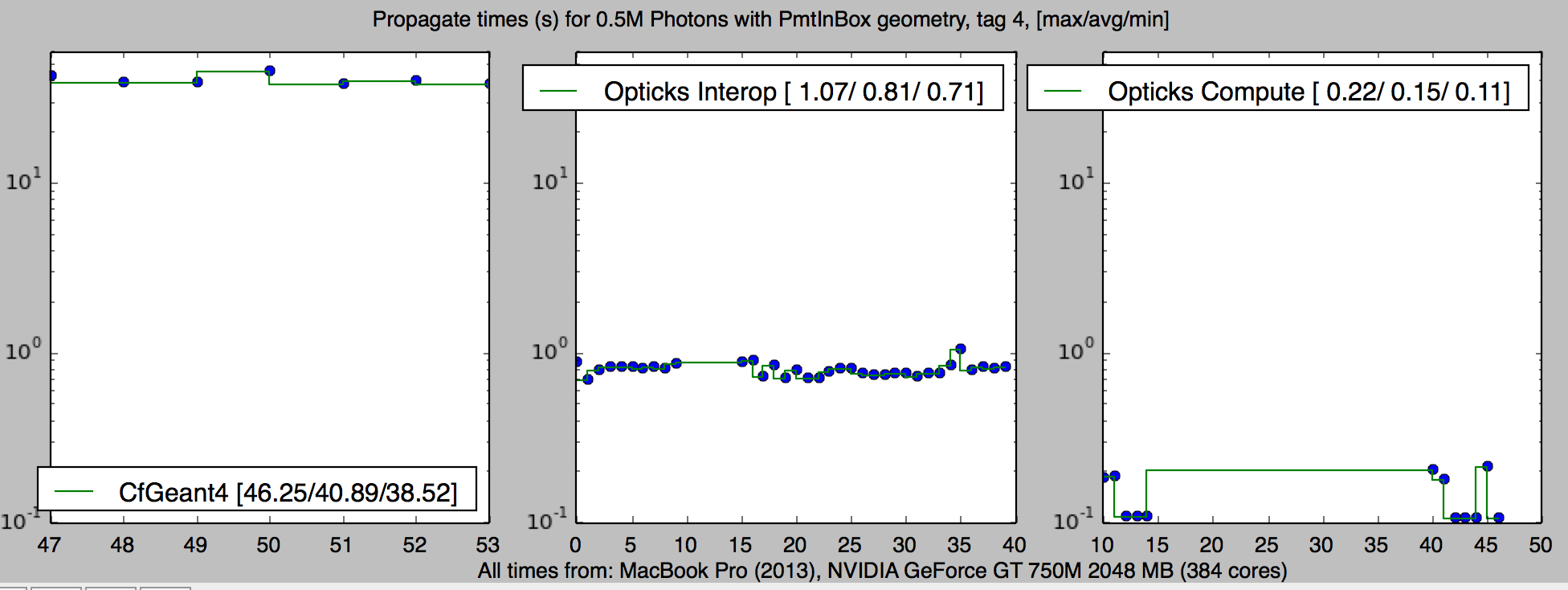
| Test | Geant4 10.2 | Opticks Interop | Opticks Compute |
|---|---|---|---|
| Rainbow 1M(S) | 56 s | 1.62 s | 0.28 s |
| Rainbow 1M(P) | 58 s | 1.71 s | 0.25 s |
| PmtInBox 0.5M | 41 s | 0.81 s | 0.15 s |
- Opticks > 200X Geant4 with only 384 core mobile GPU[1] (multi-GPU workstation up to 20x more cores)
- photon propagation time will become effectively zero
- Interop uses OpenGL buffers allowing visualization, Compute uses OptiX buffers
- Interop/Compute : perfectly identical results, monitored by digest
[1] MacBook Pro (2013), NVIDIA GeForce GT 750M, 2048 MB, 384 cores
Summary
Overview
- Opticks 200x Geant4 with mobile GPU
- Expect: Opticks > 1000x Geant4 (with workstation GPUs)
- photon propagation time --> zero
- analytic geometry --> precise Geant4 match

Opticks enables particle physics to benefit from optical photon simulation taking effectively zero time and zero CPU memory, thanks to massive parallelism made accessible by NVIDIA OptiX.

- The more photons the bigger the overall speedup (99% -> 100x)
- Drastic speedup -> better detector understanding -> greater precision
- Large PMT based neutrino experiments, such as JUNO, can benefit the most

YouTube Video
JPMT After Contact
http://simoncblyth.bitbucket.io/env/graphics/ggeoview/jpmt-after-contact_half.png
JPMT Inside Outside
http://simoncblyth.bitbucket.io/env/graphics/ggeoview/jpmt-inside-outside_half.png
Photon History Selection
Only CK BT BT BT SA, three boundary transmits before surface absorption
OptiX Experience
Geometry Issues Fixed/Avoidable
- triangulated geometry leaks when shoot millions of photons at cracks (more a problem for testing than usage)
- bounding boxes that touch geometry cause leaks, slightly enlarging the boxes avoids leak (<1 in 3M)
Use cuRAND in OptiX without large stack
Init in separate CUDA launch, persist cuRAND state, subsequently load into OptiX context : avoids large stack performance hit
Compositing OptiX Ray Trace and OpenGL Rasterized
- best of both worlds : rasterization speed, raytrace accuracy
- OptiX : replace uchar4 alpha with Z clip depth
- OpenGL : fragment shader, set gl_FragDepth
out vec4 frag_colour;
uniform sampler2D ColorTex ;
void main ()
{
frag_colour = texture(ColorTex, texcoord);
float depth = frag_colour.w ;
frag_colour.w = 1.0 ;
gl_FragDepth = depth ;
...